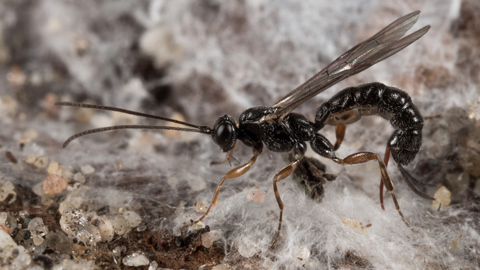World’s First Parasitoid Wasp with the Ability to Felt Discovered in Finland
Parasitoid wasp researchers Niclas Fritzén and Ilari E. Sääksjärvi from the Zoological Museum of the University of Turku are studying the behaviour of a mysterious Clistopyga wasp. They discovered that the wasp felts spider silk with its felting needle-like organ called an ovipositor.
This remarkable discovery was published this week in the esteemed Biology Letters journal of the Royal Society. This new study diversifies our understanding of the functions and evolution of the wasps' ovipositor or venom stinger.
The insect order for wasps is one of the world's most species-rich and includes e.g. wasps, bees, ants and parasitoid wasps. Even in Finland, there are over 6000 wasp species. Most of the wasps are parasitoids or insect parasites. They lay their eggs on or inside other insects and spiders. The hatching wasp larvae eat the host until they pupate. All female parasitoid wasps have a sharp ovipositor which is used for the laying of eggs and as a piercing organ for injecting venom.
Fritzén and Sääksjärvi have been studying the diversity of parasitoid wasps in different parts of the world for years. They conducted one of their most interesting wasp study in Finland.
– The discovered parasitoid wasp species, which is possibly unknown to science, belongs to the genus Clistopyga whose biology has been quite unknown. We were able to observe and document the behaviour of the wasp with the help of an HD video shot through a microscope. First, the female wasp paralysed the spider hiding inside the silken nest with venom injection and laid its eggs on it. Then, the parasitoid wasp closed the spider's silk nest by felting the silk carefully with its ovipositor, describes Fritzén.
This new discovery from the west coast diversifies our understanding of the functions of the ovipositor of wasps. The now discovered way of using the ovipositor has not been previously observed on any other insect.
– In addition to the behaviour study, we examined the fine mechanisms of the ovipositor with a scanning electron microscope. In the end, we compared the ovipositor with the felting needle used by humans. The similarities were astonishing! One might even say that humans did not invent the felting needle. Wasps might have developed it already millions of years earlier, note Fritzén and Sääksjärvi.
According to the new study, Clistopyga wasps are parasites to at least jumping spiders. Unlike many other spiders, spiders of the Salticide spider family do not usually weave a web to catch prey. Instead, they weave a silk nest to protect their eggs and they stay in the nest on guard. A similar silk nest also works as a hiding and hibernation place for jumping spiders.
– Clistopyga parasitoid wasp stings the spider cleverly through its silk nest or by reversing into the nest through its entrance hole. When closing the nest by felting, the wasp ensures that other predators and parasites cannot reach the larva or its nutrition, considers Fritzén.
The species on earth are still poorly known. The researchers from the Zoological Museum of the University of Turku have already discovered hundreds of parasitoid wasp species unknown to science from different parts of the globe during the last two decades.
– In addition to Finland, our research team is conducting field work in the Amazon and tropical Andes where a great deal of unknown species are still found. This new discovery proves that incredible species still live even in Finland and nothing is known of their biology yet. Parasitoid insects keep on astonishing people with their diversity and unusual behaviour, says Sääksjärvi.
>>Read the article published in the Biology Letters of the Royal Society

Text: Ilari Sääksjärvi, Erja Hyytiäinen
Translation: Saara Yli-Kauhaluoma
Photos: Ilari Sääksjärvi, Niclas Fritzén